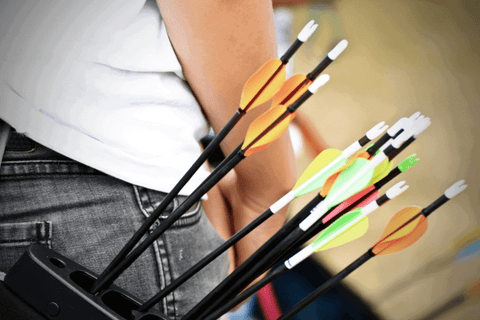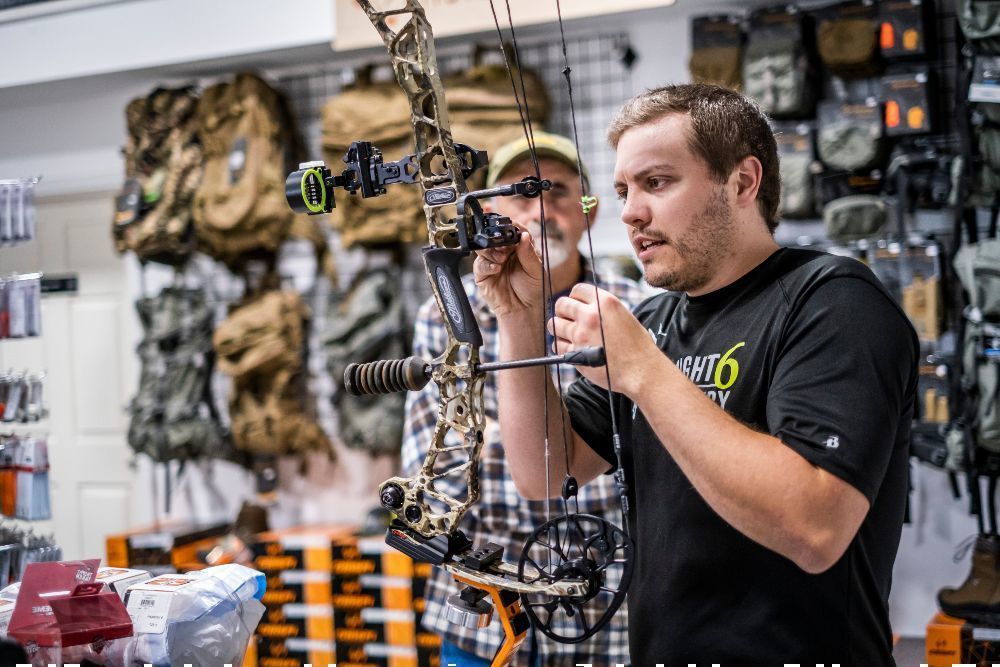Picking out and buying your first set of archery equipment might feel like a big undertaking. But it doesn’t have to be. What gear you buy will depend on whether you want to compete in archery tournaments, go bowhunting, or just shoot for fun in your backyard every now and then.
Although each activity is unique and calls for its own set of equipment, this post will focus on the essentials shared by all fields of archery. Everything you need to know is explained in this post. What to look out for and the mistakes to avoid when buying archery gear, along with how to select the best quality new equipment for you and your skill level.
Let's dive in, pick out the perfect gear for you, and get the basics down.
The Essential Archery Equipment List For Beginners
Learning archery is a fun and exciting adventure. But to enjoy the sport to the fullest, it’s important you buy equipment that is right for you. Moreso, your archery skills will improve better when you have your gear handy for practice.
Below is a quick and easy guide on buying your first set of equipment:
Bows and Bow Cases
The first piece of equipment on our list is bows for obvious reasons. Archery and bows pretty much go hand-in-hand. Hence, they are the most essential equipment for archery. There’s a long list of bow types, but the two most common are recurve and compound bows. Decent beginner or hunting bows usually come equipped with all the basics you need to start shooting, including the limbs, riser, and bowstring, but if you’re going for Olympic target bows, you’ll have to get these components separately.
-
Recurve Bow

Recurve bows are the bow type you see in the Olympic games. While they are commonly used for target archery, some bowhunters also use them for hunting. Modern recurve bows feature rods for balance, weights for stability, and sights for aiming.
Generally, recurve bows are relatively easier to buy and use. As long you get your measurement right, you’re good to go. They require less tuning, and for most models, you can start shooting as soon as you unbox and set them up. This simplicity makes them especially attractive for new archers.
-
Compound Bow

This bow is the most advanced of its kind, with its origins in the 1970s, and is known for its pinpoint precision. They are the go-to bows for bowhunters because of their incredible speed and force. Many archers, however, use it for competition shooting and target shooting. With the aid of the in-built cams, even heavier bows can be drawn and held steady at full draw.
Tuning a compound bow can be a bit more difficult, owing to its cams and accessories. If you purchase one online, you will likely need to take it down to a local archery shop to have them time it for you. Some brands, however, have YouTube video guides that can help you out. An upside to compound bows is that they can be much easier to aim and shoot and can help you hit your target more easily once you are able to get them tuned right.
When it comes to bows, there really is no right option. The choice is entirely up to you and your personal preference. Many archers actually end up using both bow types over the course of their archery journey. Regardless of the bow you choose, you’ll need a bow case, not just to shield the bow from damage but also to facilitate its easy transportation.
Arrows

Arrows are another crucial component of any archery kit. There are tons of arrow options on the market, but the arrow and point combination best suited for you will depend on your bow type, archery field, and draw length and weight. If you’re confused, your best bet is to head to a local archery store to get recommendations from professional bow technicians.
There are three main arrow types: carbon, aluminum, and wood arrows. Carbon arrows are a favorite among bowhunters and compound archers - although some recurve archers also use them. Aluminum arrows are especially great for beginners and are used by compound and recurve archers alike. While they are not so common anymore, wooden arrows are your best bet if you ever decide to try out traditional archery - you’ll probably even learn to make yours. Wooden arrows can also be used with recurve bows, but because they are more fragile than carbon and aluminum, they are not recommended for compound bows.
Having a quiver with a minimum of twelve arrows is recommended for almost every kind of shooting. And as stated earlier, the type of arrows you should use depends on two factors: the type of archery you're practicing and your personal preference.
Finger Tabs/Gloves

You can protect your fingertips from the bowstring by using finger tabs, which are little pieces of leather or cloth. A finger tab is designed to shield the archer's fingertips from injury during a shot. Pulling back on the bowstring can cause discomfort to the shooter's fingertips, but a finger tab keeps the string from cutting in. If you need to get a lot of shots off quickly, archery finger tabs or gloves are a must-have accessory.
Armguard

Armguards, often called bracers, are used by archers to protect their forearms from injury caused by string slaps and to keep their clothes out of the way of their aim. Beginners are usually at the highest risk of wrist slaps and tend to need arm guards the most. However, in some snap situations, even some of the best pro archers experience wrist slaps.
Other Archery Accessories
In addition to the above-mentioned gear, these items will make your archery practice considerably more productive and enjoyable:
- Bowstring
- Nock
- Targets
- Stabilizers
- Sights
- String silencers
- Cam protector
How to Pick Out Your First Set of Archery Equipment

If you are just getting into archery or bowhunting, then you need to invest in some high-quality gear. As you prepare to purchase your first set of equipment, here are five (5) things to bear in mind (in no particular order):
1) Steer clear of any gear that’s too heavy
This is by far the most common blunder made by archers while shopping for new equipment, particularly bows. Holding the bow steady while shooting ensures that the arrow will travel in a straight line. If the bow is excessively heavy, the archer won't be able to keep it steady for too long. If you can't keep the bow level and stable, your aim will suffer.
Furthermore, one's age should be considered when choosing a bow of the appropriate size. The starting weights for youngsters and adult beginners are different. Nevertheless, lighter is always preferable to heavier, as well as more convenient. So keep that in mind while shopping for your first bow.
The chart below displays the typical bow weight for different ages of new archers.
|
Age |
Weight |
|
8 to 13 |
10 – 14 pounds |
|
14 to 17 |
12 – 16 pounds |
|
18 to 20 |
12 – 22 pounds |
|
Adult Women |
16 – 26 pounds |
|
Adult Men |
26 – 30 pounds |
2) Set a budget
Since there are several bow setups for each archery field or type, the first step is to determine how much money you are willing to spend on your first equipment set. Archery may be as cheap or expensive as you make it. You can expect to spend between $100 and $2000 to get your first set of equipment. So, how much should you really spend? If you're just starting out, it's probably best to start with an entry-level set of equipment, and then, as your skills improve, you can upgrade to more advanced equipment. Another option is to invest more money upfront in high-quality equipment that will serve you well for many years to come.
3) Determine if you’re left or right-eye dominant
Everyone has a dominant eye, just as we all have a dominant hand - you are either right-handed or left-handed. The dominant eye of many individuals is located on the same side as their dominant hand. Some cases are, however, different.
Identifying your dominant eye is crucial for shooting since it will relay information about the location of the target to your brain. You won't be able to hit your target with as much precision if you fire with your non-dominant eye since your brain will get somewhat distorted information about its location.
Right-handed people who are also left-eye dominant have two alternatives when it comes to shooting a bow: they may either switch to a left-handed bow or cover their dominant eye with a patch. Although the best course of action is contentious, you can test out both options at the archery store to determine which is best for you.
You can determine eye dominance with the Miles Test by following the guide below:
The Miles Test:

- Raise your arms out in front of you, palms facing out, until they are level with your eyes.
- Bring your hands together and overlap your thumbs and index fingers to form a "V."
- Keep your eyes open and fixate on a distant object, no closer than 10 feet away.
- While concentrating on the item, close and then open one eye.
- Maintaining your focus on the item, shut and open your other eye.
When you closed one eye, did the item vanish behind your hands? If so, your open eye is not dominant. If you were able to keep the item focused while closing one eye, then the open eye is your dominant eye.
4) Get your draw and arrow length right
It is standard practice for archery shops to measure customers' draw lengths upon arrival. However, you should always double-check that your draw length matches the bow's draw length. If the draw length is off, you either won't be able to fire the bow or you'll do serious harm to the bow each time you try to fire it. Also, you can't safely shoot unless your arrows are the right length for your bow. It's important that, when drawn to full length, the arrow can rest securely on the rest without slipping off. So, have the bow specialist at the store customize the arrow length to match your needs.
5) Test every piece of equipment you intend to buy

Before settling on a bow, it's a good idea to put a variety of them to test. When you're just getting started with archery or getting acclimated to the weight of the draw and the feel of your bow, it's crucial to find a reliable archery shop that has a wide variety of brands and offers follow-up support and guidance. If your gear is brand new, you can expect to make some minor adjustments, which you could miss if you don't try out as many different settings as possible.
Final Tip
You needn’t visit a physical store before you can get yourself the perfect archery accessories, as well as entry-level and brand new equipment. Contact a competent online archery store today to discover several archery gears on-sale and for how much. You can also learn from customers' feedback, get valuable advice from seasoned pros, and ultimately, make an informed decision while shopping for the set of archery equipment that’s ideal for you.
 cust@legendarchery.com
cust@legendarchery.com 302 503 5767
302 503 5767 Sauk Village IL 60411
Sauk Village IL 60411


